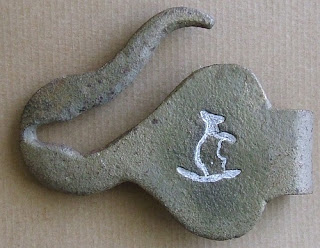Marcus played soccer at Grove Road, Glenorchy yesterday. He needs to arrive 45 minutes before kickoff, and my usual drill is to walk around the neighbourhood for most of that time and arrive warmed up and ready to run up and down as a linesman or just sit and watch with a little bit of circulation going.
On my walk yesterday I went down a random side-street and found this ruin. It's on the property of McKay Timber. I have since looked it up, and its a massive block of land, 27 acres, dotted with stacks of drying timber. The white building in the background is a timber kiln I think.
 |
| Still from the above StreetView |
So after a quick bit of digging this morning I found this note from the Glenorchy Planning Authority. They had asked the owner for consent to add it to the heritage list, and they had refused.
The ruins are in a bare setting with timber yards to the west. The former house is
clearly visible from the end of McKay Street. The house was built by Captain John
Briggs in c.1840 and later acquired by Stephen Wright in 1868. Under the Wright
family The Grove became an iconic Glenorchy property with a large orchard and
extensive hop grounds which provided seasonal employment for local residents. By
1890 the Wright’s were the colony’s largest fruit growers. By 1933 the Wright’s glory
days had been eclipsed and the house and fine gardens were subsequently
abandoned. The property became part of a timber yard after World War 2 and the
dilapidated house was subsequently destroyed in a fire in c.1992.
I could tell by the ornate arch that this was probably a residential building and had been built with a lot of care, but I would have guessed 1890s.
 |
| This photo is from the excellent and moving blog post about the house, by Warren Dent. |
I took the photos below with my crappy phone; these will have to do until I get back there with a proper camera. McKay's planned to demolish the ruin after the fire in 1992, but their permission expired before they accomplished this. I assume they are now just waiting for the weeds and weather to do it for them. GPA would like to to a survey and explore the area to learn more about the orchard and the family who were such a prominent part of early Glenorchy – I hope that before it's too late the current landowners choose to cooperate.
 |
| This corner of Glenorchy now a mix of residential and warehouses. Very quiet on a Saturday. There is early-spring snow on Mt Wellington. |
 |
| Looking back towards Grove Rd, and beyond it the Brooker Highway and Montrose Bay. The old house's upper storey would have had pleasant water views over the orchard. |
 |
| This neighbouring warehouse takes a stern view of… something. |
 |
| Entropy by Anon [timber sleeper chunks, car body, 2017] |
























